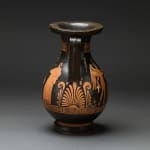Apulian Red-Figure Pelike, 400 BCE - 300 BCE
Terracotta
height 35.6 cm
height 14 in
height 14 in
AM.0017
Further images
Pelike is the term used to describe a type of amphora with two handles, where the broadest part of the body is below the mid-point of its height. The shape...
Pelike is the term used to describe a type of amphora with two handles, where the broadest part of the body is below the mid-point of its height. The shape of the vessel was originally designed as a storage receptacle for liquids, particularly oil and wine, but it is likely that elaborately decorated examples such as this one served a funereal purpose.
The obverse depicts a seated female wearing a belted peplos. In her right hand she holds a thyrsus with a fillet attached and in her left hand a wreath. A winged figure of Eros stands opposite, holding a phiale in his outstretched left hand and a bunch of grapes in his right hand. His hair is secured under a sakkon. These figures are flanked on both sides by a palmette design. The upper register, beneath the rim, is adorned with a rosette and dotted ovolo motif. The lower section is encircled by a meander design, typical of Apulian production.
The reverse shows two young draped males facing one another. The figure on the viewer’s left holds a staff in his right hand. Between them hang a pair of weights, a symbol of the palaestra, or wrestling school. Again, the figures are flanked on either side by a palmette design, but the design of the upper register is different from that on the obverse. It consists of a laurel wreath pattern, while the meander design is continued in the lower register.
The obverse depicts a seated female wearing a belted peplos. In her right hand she holds a thyrsus with a fillet attached and in her left hand a wreath. A winged figure of Eros stands opposite, holding a phiale in his outstretched left hand and a bunch of grapes in his right hand. His hair is secured under a sakkon. These figures are flanked on both sides by a palmette design. The upper register, beneath the rim, is adorned with a rosette and dotted ovolo motif. The lower section is encircled by a meander design, typical of Apulian production.
The reverse shows two young draped males facing one another. The figure on the viewer’s left holds a staff in his right hand. Between them hang a pair of weights, a symbol of the palaestra, or wrestling school. Again, the figures are flanked on either side by a palmette design, but the design of the upper register is different from that on the obverse. It consists of a laurel wreath pattern, while the meander design is continued in the lower register.





